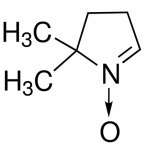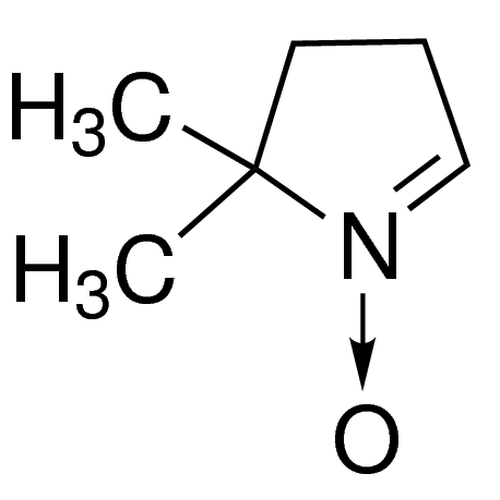| Product Name | DMPO |
| Description |
Spin trapping reagent |
| Purity | >98% |
| CAS No. | 3317-61-1 |
| Molecular Formula | C6H11NO |
| Molecular Weight | 113.16 |
| Field of Use | Not for use in humans. Not for use in diagnostics or therapeutics. For in vitro research use only. |
Properties
| Storage Temperature | -20ºC |
| Shipping Temperature | Shipped Ambient |
| Product Type | Agent, Small Molecules |
| Solubility | Soluble to 100 mM in ethanol and to 100 mM in DMSO |
| Source | Synthetic |
| Appearance | Liquid |
| SMILES | CC1(CCC=[N+]1[O-])C |
| InChI | InChI=1S/C6H11NO/c1-6(2)4-3-5-7(6)8/h5H,3-4H2,1-2H3 |
| InChIKey | VCUVETGKTILCLC-UHFFFAOYSA-N |
| Safety Phrases |
Classification: Harmful. May be harmful if inhaled, swallowed or absorbed through skin. Safety Phrases: S22 - Do not breathe dust S36/37/39 - Wear suitable protective clothing, gloves and eye/face protection S24/25- Avoid contact with shin and eyes |
| Cite This Product | DMPO (StressMarq Biosciences Inc., Victoria BC CANADA, Catalog # SIH-324) |
Biological Description
| Alternative Names | 2,2-Dimethyl-3,4-dihydro-2H-pyrrole 1-oxide, 5,5-Dimethyl-1-Pyrroline-N-Oxide, 3,4-dihydro-2,3-dimethyl-2H-pyrrole 1-oxide |
| Research Areas | Cancer, Oxidative Stress |
| PubChem ID | 1774 |
| Scientific Background | The formation of free radicals and other highly reactive oxygen species has been implicated in the pathogenesis of many disease states (1). The ability to identify these species is crucial, and spin trapping has accomplished this goal. DMPO (5,5-dimethyl-1-pyrroline N-oxide) is one of the least toxic to cells and animals, and possesses convenient pharmacokinetics (uptake, distribution, metabolism and excretion) in biological systems (2-6). Recent studies have determined that nitric oxide may substantially affect the quantitative determination of DMPO adducts, and therefore extra caution is required when studying generation of these species in the presence of nitric oxide or its radicals (1). DMPO adducts can be generated with protein and DNA radicals (7). |
| References |
1. Reszka K.J., et al. (2006) Nitric Oxide 15: 133-141. 2. Ramirez D.C., Gomez-Mejiba S.E., and Mason R.P. (2007) Nat Protoc. 2(3): 512-522. 3. Khan N., et al. (2003) Free Radic. Biol. Med 34:1473–1481. 4. Haseloff R.F., et al. (1997) FEBS Lett 418:73–75. 5. Schaefer C.F., Janzen E.G., West M.S., Poyer J.L., and Kosanke S.D. (1996) Free Radic. Biol. Med 21:427–436. 6. Anzai K., et al. (2003) Arch. Biochem. Biophys 415:251–256. 7. Chatterjee S., Ehrenshaft, M., Bhattacharjee ,S., Derterding, L.J., Bonini, M.G., Corbett, J., Kadiiska, M.B., Tomer K.B. and Mason, R.P. 2009 Free Radic. Med. and Biol. 46:454-461. |



Reviews
There are no reviews yet.